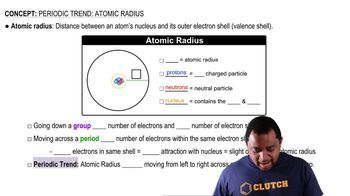Here are the essential concepts you must grasp in order to answer the question correctly.
Ionization Energy
Ionization energy is the energy required to remove an electron from a gaseous atom or ion. It generally increases across a period due to increasing nuclear charge, which attracts electrons more strongly. Conversely, it decreases down a group because the outer electrons are farther from the nucleus and experience greater shielding from inner electrons, making them easier to remove.
Recommended video:
Atomic Radius
Atomic radius refers to the size of an atom, typically measured from the nucleus to the outermost electron shell. As one moves down a group, atomic radii increase due to the addition of electron shells. In contrast, moving across a period, atomic radii decrease because increased nuclear charge pulls the electron cloud closer to the nucleus, reducing the size of the atom.
Recommended video:
Trends in the Periodic Table
Trends in the periodic table, such as those for ionization energy and atomic radius, reflect the underlying principles of atomic structure and electron interactions. As you move down a group, ionization energy decreases and atomic radius increases, while moving across a period shows the opposite trend. Understanding these trends helps predict the behavior of elements in chemical reactions and bonding.
Recommended video:




